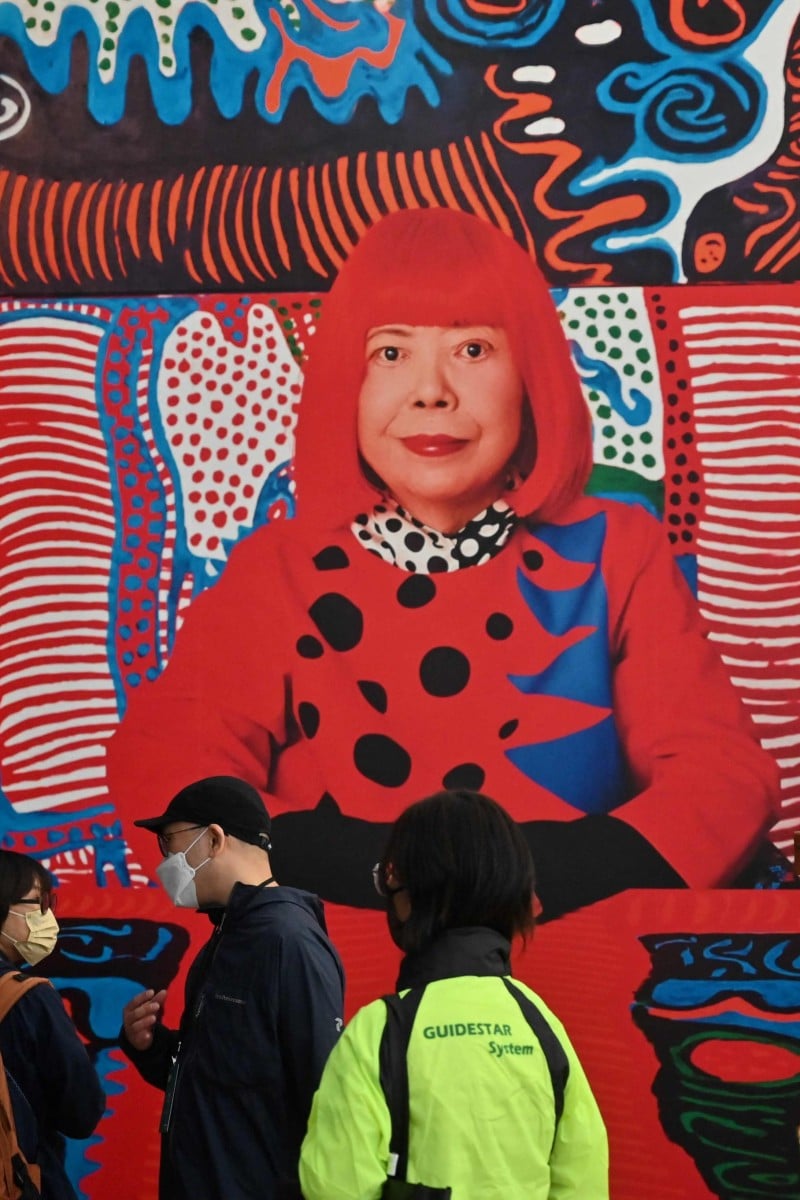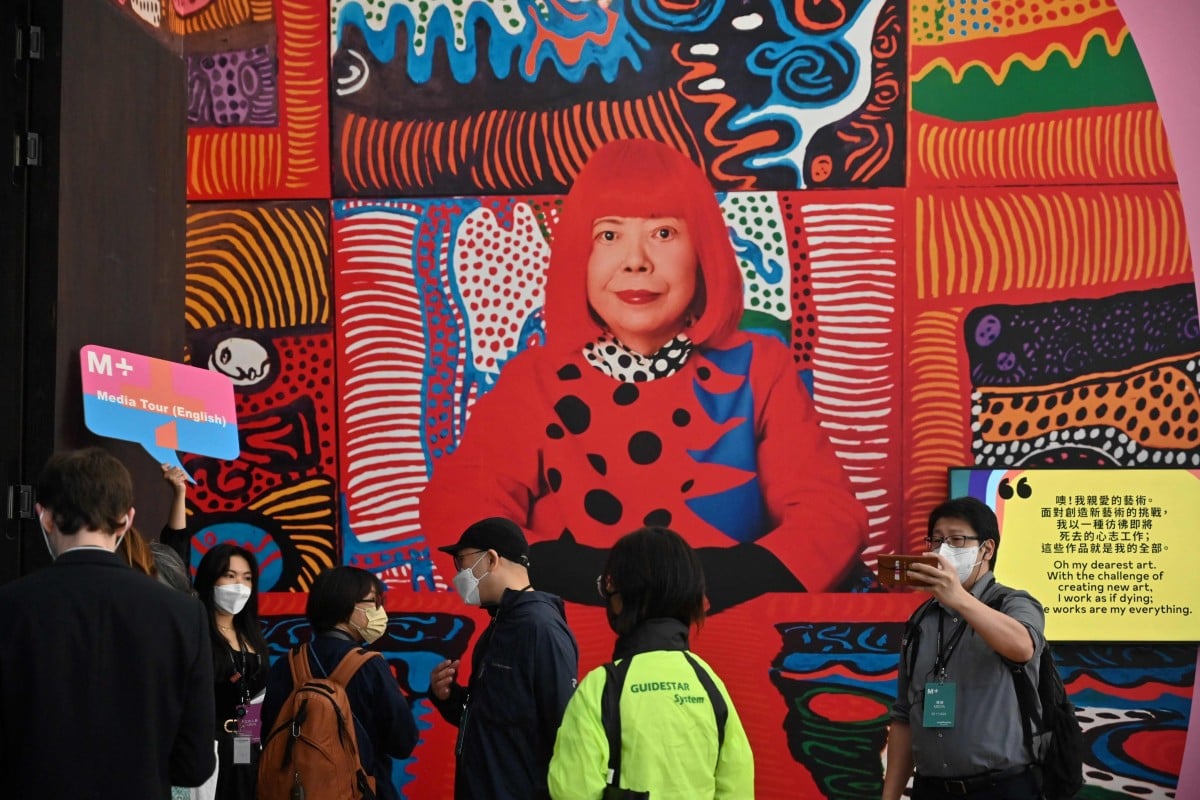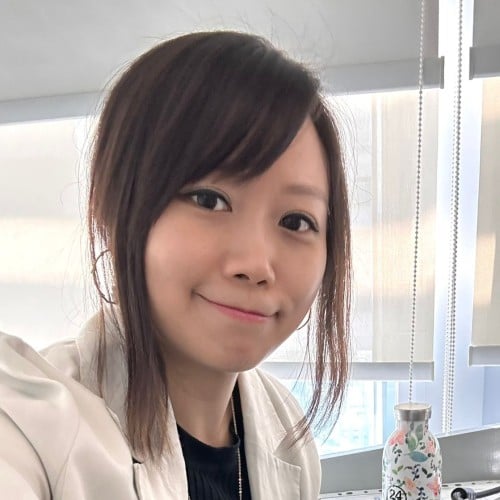
Explore the life and art of Yayoi Kusama, ‘the princess of polka dots’, at Hong Kong’s M+ museum
- Learn more about the avant-garde Japanese artist known for her colourful paintings and iconic dotted pumpkins
- Kusama’s work often reflects on society and her struggles with her mental health
 Members of the media attend a press preview tour of the new exhibition “Yayoi Kasuma: 1945 to Now” at M+ museum. Photo: AFP
Members of the media attend a press preview tour of the new exhibition “Yayoi Kasuma: 1945 to Now” at M+ museum. Photo: AFPMany know Yayoi Kusama as “the princess of polka dots”, but the famous Japanese contemporary artist has more to offer than her iconic dotted pumpkin. The 93-year-old cultural icon is still creating art that captivates the world with its vivid use of colour, relentless dots, and complex texture. More than 200 of her pieces can now be seen in Hong Kong’s M+ in an exhibition titled Yayoi Kusama: 1945 to Now, which will last six months.
According to the exhibition’s co-curator, Mika Yoshitake, the exhibit will answer the question: who is Kusama? It will narrate the story of the artist’s life and work. Even Kusama devotees could see a different side of her since the retrospective showcases many of the early pieces she made as a teenager during the Second World War. The show has been arranged under six themes: Infinity, Accumulation, Radical Connectivity, Biocosmic, Death, and Force of Life.
Can John Lee’s plans for reviving Hong Kong’s music and arts scene strike the right note?
Tickets for the Kusama exhibition can be found on the M+ website and cost $150 for full-time students and $240 for adults. The entry includes access to other collections in the museum.
The exhibition includes a wide range of paintings, installations, sculptures, drawings, collages, moving images and archival materials – including three brand-new pieces for Hongkongers only. We have highlighted a few parts that Young Post readers may enjoy:
1. Pumpkin (2022)
M+ main lobby
You cannot miss the two pumpkin sculptures in the main lobby of M+, as there will always be a long queue of people waiting to take pictures with these iconic pieces. Kusama’s fascination with pumpkins can be traced to her childhood. ccording to the artist, she likes making pumpkins because they are attractive in colour and form and are also tender to the touch.
2. Dots Obsession – Aspiring to Heaven’s Love (2022)
The Studio on B3 Level
This immersive experience brings visitors into a dark studio covered in reflective mirrors, filled with giant balloons decorated with black-and-white dots suspended from the ceiling. Then, going deeper into The Studio, one will enter a cubic environment which provides a kaleidoscopic perceptual experience brought by the repetition of dots and the illusion of infinite space.
3. Death of Nerves (2022)
M+ ground floor & B2 level
This installation, commissioned by M+, is a mixed-media work utilising stuffed fabric. The larger part of the piece has been draped from the museum’s ground floor to the B2 level, while a smaller one can be found inside the exhibition hall under the theme of Death. This alludes to the fact that making art has allowed Kusama to process her fascination with death and persevere through her depression.
4. Self Obliteration (1966-1974)
West Gallery
This installation shows a dinner scene, with patterns of dots painted on mannequins, a table, chairs, wigs, handbags, mugs, plates, plastic plants, and plastic flowers, creating a repeating loop and giving the illusion that the human figures and objects have blended and unified as one. The title, “Self Obliteration”, alludes to the idea that the destruction of the self can lead to the freedom to reconnect with others and the world as equals.
Artist, chef Cam Wong explores how Hong Kong’s food habits have changed in new exhibition
5. Accumulation of Hands (1980)
West Gallery
Kusama covered a furniture set with silver-painted gloves, including a sofa and two lounge chairs. This playful image prompts the feeling of excess and offers a wry reflection on an era of mass production and overconsumption.
6. Clouds (2019)
West Gallery
These light, airy sculptures, made of smooth stainless steel and formed in different shapes and sizes, have been specially placed on the floor by the window because of the dawn view of the room, according to Yoshitake.
If you happen to visit during sunset, do take a moment to pause and contemplate this view. The reflections bouncing off the clouds allow you to see many unique perspectives.
Artist behind Instagram page Moving Drawing shares joy, comfort in cartoons of moments on MTR
7. Accumulation of the Corpses (Prisoner Surrounded by the Curtain of Depersonalization) (1950)
West Gallery
Many believe this piece – an oil painting of two tiny, bleak trees surrounded by a spiralling tunnel of red doom in a sea of repetition – is Kusama’s way of counteracting violence with art and activism.
However, it may reflect more deeply on the artist’s thoughts at the time as well, as Kusama often felt isolated from the world, with anxiety separating her from reality and other people.
8. Pound of Repose (2014)
West Gallery
Ending on a positive note, the last theme of the exhibition is the Force of Life, displaying Kusama’s pieces that have spread the message of love, peace and collectivity since the 1960s. This allows you to leave the museum feeling refreshed by the bright and happy colours in a space full of life. “Pound of Repose,” which features a bright yellow background, is one of the most iconic pieces in this part of the exhibition and showcases the healing power of art.
